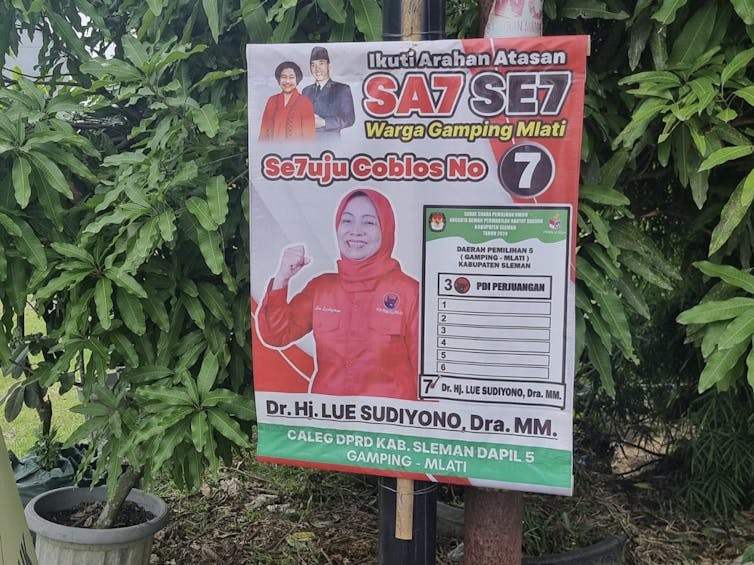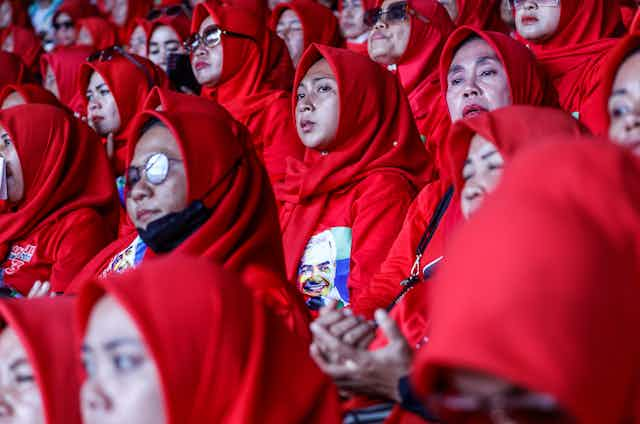In the 2019 general election, Indonesians voted more women into the national parliament than ever before.
After the first election of the post-authoritarian period in 1999, women’s representation was a paltry 8.8%, so the rise to 20.9% in 2019 seemed worth celebrating. Indeed, women activists had worked long and hard to reach this point.
Disappointed with the results of the first two elections, they had successfully pushed for a candidate quota, requiring parties to nominate at least 30% women.
This will again be tested in next week’s election. But given the barriers women candidates in Indonesia face, is the quota enough to raise representation?
Read more: Is Joko Widodo paving the way for a political dynasty in Indonesia?
Representation better, but not enough
Under Indonesia’s open list proportional representation system, parties decide on candidate placement on the list, but voters can choose any candidate. In the past three elections, the quota has meant that in every electoral district at all three levels of parliament, women had to make up at least 30% of candidates. Additionally, one in every three candidates on the party list had to be female.
With such a strong institutional framework, it is not surprising that enthusiasm after the 2019 election was muted. Given the 2014 election had seen a slight fall in women’s representation, activists were relieved. But the result was still well below the aspirational 30% target, and below the international average at the time of 24.3%.

The results were also uneven, with more than 20% of electoral districts not electing any women to parliament. At the provincial and district level, the proportion of women elected to office was even lower, at only 18% and 15% respectively; 25 district parliaments had no women at all elected to office in 2019.
Why do women find it hard to be elected to office in Indonesia, and is this likely to change in 2024?
Barriers of patriarchy, money and name recognition
In many countries, it is said that when women run, they win. The main barrier to greater representation tends to be that women don’t stand for office. When they do, political parties don’t nominate them, or put them in unwinnable positions.
The quota in Indonesia gets around this problem. It encourages women to run and forces parties to nominate them. But our research has revealed that women candidates in Indonesia also face significant barriers from patriarchal attitudes held by many voters about whether women should take on political leadership roles.
Support for women’s political leadership has even dropped over the past decade. Meanwhile, Indonesia’s electoral system allows voters to discriminate against women without having to sacrifice party choice, as they would in a majoritarian voting system like that in Australia.
But the challenges don’t stop there.
Indonesia is a new democracy and political parties receive very little public financing. Candidates are expected to raise their own funds to run their campaigns.

The open-list system means candidates run not just against opponents from other parties, but also against their fellow party members, making politics highly personalised. This has led to a dramatic rise in the cost of elections for individual candidates, with “money politics” coming to dominate election campaigns.
Given that women in Indonesia face high levels of economic inequality, the cost of campaigns makes competing difficult.
Clientelism also shapes the kind of women candidates that parties choose and where they place them on their lists. Elite women and celebrities are more likely to be nominated as they can finance themselves. They also have the networks and name recognition that can garner votes. In 2019, some 44% of the women elected to the national parliament were members of political dynasties.
While some of these women are no doubt capable politicians, their dominance makes it harder for women candidates to come through grassroots organisations. Parties also spend less time developing women cadres to run as candidates, preferring to reach out to such “vote getters”.
What about this time around?
So what are the prospects for women’s representation in the upcoming elections?
The barriers to women’s election have not changed and are unlikely to change in the short term. As a result, incremental progress is the best that can be hoped for.
Several women politicians were instrumental in the passage of the Anti-Sexual Violence bill that passed last year. It’s possible that this increased visibility will give women a bump.
On the other hand, gender issues have not been central to the presidential or legislative campaigns so are unlikely to be uppermost in voters’ minds.

In fact, we may have reason to be more pessimistic. A seemingly minor change to the regulations on quota implementation means that for the first time in three elections, the requirement for a 30% candidate quota will not be applied in every electoral district party list, but instead for the total number of women candidates of each party.
The changes date back to a controversial regulation issued by the Indonesian Electoral Commission (KPU) in April 2023. The regulation allowed rounding down when assessing the number of women a party has on a candidate list. For example, in electoral districts with eight seats, 30% is 2.4 candidates. Previously, a party would have had to field three women candidates. Now, fractions can be rounded down if under 0.5, so in our example, parties are only required to field two women candidates.
A coalition of democracy and gender activists appealed against this regulation to the Supreme Court, and they won. But the electoral commission has indicated it will not enforce the court’s decision in this election. Democracy activists say that this means almost 18% of party lists do not meet the requirement for 30% women candidates.
It could be that these changes will have little impact. After all, we know that most candidates are elected from the first position on the list.
However, it sets a worrying precedent for women’s representation going forward. Our research shows the 30% candidate quota for women is widely supported in Indonesia. Yet, it has effectively been watered down without public discussion and against the advice of the Supreme Court.
The actions of the electoral commission, apparently at the direction of a male-dominated parliamentary commission, underline again how the foundational institutions of Indonesian democracy are being eroded by the political elite.

